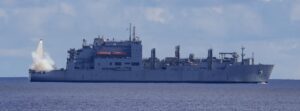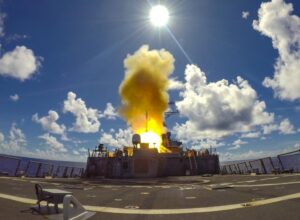The Kratos [KTOS] BQM-177A next-generation subsonic aerial target (SSAT) for the Navy reached full operational capability (FOC) on Aug. 28 with a missile intercept test during an international exercise in the Philippine Sea.
The target drones were launched from the Lewis and Clark
-class dry cargo ship USNS Alan Shepard (T-AKE 3) then targeted and engaged by missiles launched from the Arleigh Burke-class guided-missile destroyer USS Barry (DDG-52) and Royal Australian Navy Anzac-class frigate HMAS Perth (FFH 157) during the Pacific Vanguard (PV) 2022 international exercise.

The Navy noted DDG-52 launched an SM-2 missile and this was the first time the BQM-177A was used in the Western Pacific.
The BQM-177A is a recoverable target that simulates a high performance advanced subsonic anti-ship cruise missile threats to help test shipboard air defense systems. It can reach speeds upwards of 0.9 Mach and fly lower than 10 feet over the sea surface. The target can carry payloads like radio-frequency and infrared simulators to best mimic the signature of threats, tow targets and countermeasures.
PV22 is an international exercise meant to provide training emphasizing integrated task group maritime training and maneuver “in a challenging environment,” the Navy said. Participants this year included the U.S. Navy, Royal Australian Navy, Royal Canadian Navy, Japan Maritime Self-Defense Force, and Republic of Korea (South Korea) Navy.
“This exercise is focused on improving the capabilities of the countries participating to respond together as a naval force against crises and contingencies in the region. The purpose is for the participating navies to continue to refine their skills operating as an integrated force ready to respond to a changing and complex maritime environment in the Indo-Pacific region,” the Navy said in a statement.
The event concluded on Aug. 29. PV22 was the fifth time this PV event occurred with the five naval forces.

“Our primary focus in the targets community is effective, affordable training and test for the U.S. Navy,” Don Blottenberger, the Navy’s Aerial Targets program manager, said in a statement.
“The BQM-177, now fully capable, will provide quality service to our warfighters for decades to come,” he continued.
Kratos delivered the first group of 45 BQM-177As in 2018. At the time, Steve Fendley, president of Kratos’ Unmanned Systems Division, said the company planned to produce 80-100 units annually for up to several decades, which could bring $50 million to $100 million annually in revenue to the company (Defense Daily, July 12, 2018).
The BQM-177A previously achieved Initial Operational Capability (IOC) in 2019 (Defense Daily, March 5, 2019).
More recently, the Navy previously conducted test flights of the target off the coast of Japan last October (Defense Daily, Oct. 4, 2021).
At the time of those last tests, the Navy said it had received over 100 BMQ-177A targets. Pacific Missile Range Facility (PMRF) Detachment-Far East (DET FE) off the coast of Japan currently fires eight to 10 older Northrop Grumman [NOC] BQM-74 targets per year.